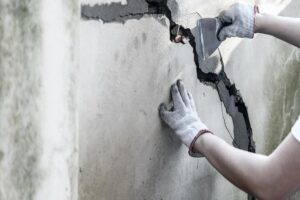 Notice cracks or uneven spots in your patio or driveway? This guide to concrete repair in Vancouver, WA, will help you discover innovative ways to fix and prevent concrete problems.
Notice cracks or uneven spots in your patio or driveway? This guide to concrete repair in Vancouver, WA, will help you discover innovative ways to fix and prevent concrete problems.
Concrete is one of the most durable building materials—but even it isn’t immune to the effects of time, weather, and ground movement. If you’ve spotted cracks, dips, or surface wear on your patio, driveway, or walkway, don’t panic. These issues are common and can often be fixed quickly with the right approach.
In this guide, we’ll explain how to identify and handle the most common types of outdoor concrete damage. Whether you’re looking for a DIY solution or considering professional help, these tips will help protect your property and restore its appearance—especially if you’re looking into concrete repair Vancouver WA.
Common Causes of Outdoor Concrete Damage
Before we jump into the fixes, it’s helpful to understand why concrete problems happen in the first place. The most common culprits include:
- Weather changes – Freeze-thaw cycles can cause expansion and cracking.
- Improper installation – Poor base preparation can lead to early settling.
- Heavy loads – Consistent vehicle traffic or equipment can stress concrete.
- Tree roots or soil movement – Natural ground shifts can lead to cracks or unevenness.
- Moisture issues – Water seeping into the concrete can cause erosion or damage over time.
Knowing the cause can help you choose the best repair strategy and prevent future damage.
1. Dealing with Concrete Cracks
Cracks are the most common issue homeowners face with outdoor concrete. They vary in size and severity, from hairline fractures to deep structural cracks.
How to Fix:
- Hairline Cracks: Use a liquid concrete filler or patching compound. These are available at most hardware stores and are great for sealing small cracks before they worsen.
- Wider Cracks: For cracks wider than ¼ inch, consider a concrete repair caulk or epoxy-based filler. These products flex with the concrete and provide a stronger bond.
Tip:
Clean the crack thoroughly before applying any filler. Dirt or debris can prevent the product from sealing correctly.
2. Repairing Settled or Uneven Concrete
If your concrete patio or sidewalk has sunken sections or is no longer at an extended level, this could be due to settling. Settling happens when the soil underneath the concrete compresses or shifts.
Solutions:
- Mudjacking (Slabjacking): A process where a mixture is pumped beneath the concrete to raise it back to level. Best for large sunken areas.
- Polyurethane Foam Injection: A more modern solution involves injecting expanding foam to lift the concrete. It’s fast, clean, and long-lasting.
- Replacing the Slab: If the damage is too extensive or the concrete is old, replacement may be more cost-effective.
For more significant settling issues, it’s wise to consult a professional offering concrete repair Vancouver WA, significantly since local soil conditions can impact the effectiveness of your repair.
- Addressing Surface Damage
Surface wear—like spalling, chipping, or flaking—is often caused by moisture exposure, freeze-thaw cycles, or using the wrong de-icing salts.
Repair Options:
- Resurfacing: A concrete overlay or resurfacing product can give your slab a brand-new look without tearing it out. It’s great for patios or pool decks.
- Concrete Patch Kits: For small surface holes or chips, patch kits can be applied with a trowel and smoothed out quickly.
- Sealants: Applying a concrete sealer can protect your surface from further damage, moisture, and UV exposure.
Preventing Future Damage
Once your concrete is repaired, take a few simple steps to extend its life and avoid repeated problems:
Actionable Tips:
- Seal your concrete regularly – every 2–3 years is ideal for outdoor surfaces.
- Avoid harsh de-icing salts – use sand or alternatives that won’t eat away the surface.
- Redirect water runoff – install proper drainage to prevent pooling or erosion.
- Limit heavy equipment on concrete surfaces – spread out weight when possible.
- Trim nearby trees – roots can lift and crack slabs if left unchecked.
Final Thoughts
Outdoor concrete takes a beating from the elements, traffic, and time. But with the proper knowledge and a little upkeep, you can keep it looking great and functioning safely for years. Whether patching small cracks or tackling significant leveling, knowing when and how to act makes all the difference.

Leave a Reply
You must be logged in to post a comment.